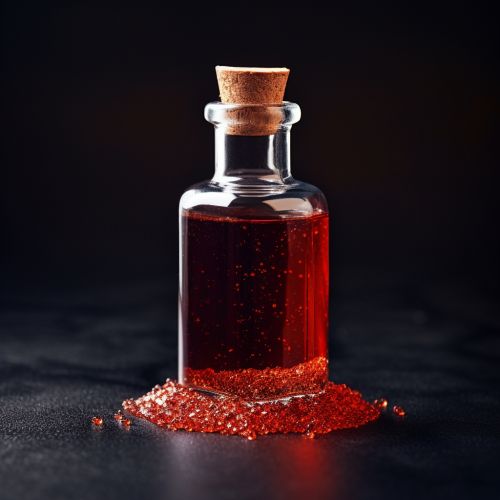Bromine
Introduction
Bromine (from Greek: βρῶμος, brómos, meaning "stench") is a chemical element with the symbol Br and atomic number 35. It is the third-lightest halogen, and is a fuming red-brown liquid at room temperature that evaporates readily to form a similarly colored gas. Its properties are thus intermediate between those of chlorine and iodine. Isolated independently by two chemists, Carl Jacob Löwig (in 1825) and Antoine Jérôme Balard (in 1826), its name was derived from the Ancient Greek βρῶμος ("stench"), referencing its sharp and disagreeable smell.

Characteristics
Bromine is the third halogen, being a nonmetal in group 17 of the periodic table. Its properties are thus a mix of those of chlorine and iodine. It is heavy, mobile, slightly volatile, highly reactive, and is less reactive than chlorine but more reactive than iodine. Bromine atoms may also bond covalently. While it is rather rare in the Earth's crust, the high solubility of the bromide ion (Br−) has caused its accumulation in the oceans.
Physical
At room temperature, bromine is a brownish-red liquid. It has a similarly colored vapor with an offensive and suffocating odor. It is the only nonmetallic element that is liquid under ordinary conditions, it evaporates easily at standard temperature and pressures in a red vapor that has a strong disagreeable odor resembling that of chlorine. Bromine is less volatile than chlorine and iodine because of increased van der Waals forces between its larger, more polarizable particles. It is somewhat more reactive chemically than chlorine and less reactive than iodine; it reacts vigorously with metals, especially in the presence of water, as well as most organic compounds, especially upon illumination.
Chemical
The electron configuration of bromine is [Ar]3d^104s^24p^5, with the seven electrons in the fourth and outermost shell acting as its valence electrons. Like all halogens, it is thus one electron short of a full octet, and is hence a strong oxidizing agent, reacting with many elements in order to complete its outer shell. Corresponding to periodic trends, it is intermediate in electronegativity between chlorine and iodine (F: 3.98, Cl: 3.16, Br: 2.96, I: 2.66), and is less reactive than chlorine and more reactive than iodine. It is also a weaker oxidizing agent than chlorine, but a stronger one than iodine.
Occurrence and production
Bromine is significantly less abundant in the crust than fluorine or chlorine, comprising only 2.5 parts per million of the Earth's crustal rocks, and then only as bromide salts. It is the forty-sixth most abundant element in Earth's crust. It is significantly more abundant in the oceans, resulting from long-term leaching. There, it makes up 65 parts per million, corresponding to a ratio of about one bromine atom for every 660 chlorine atoms. Salt lakes and brine wells may have higher bromine concentrations: for example, the Dead Sea is rich in bromide salts.
The main sources of bromine are in the United States and Israel. The element is liberated by halogen exchange, using chlorine gas to oxidize Br− to Br2. The bromine industry is about one-hundredth the size of the chlorine industry. Laboratory production is unnecessary because bromine is commercially available and has a long shelf life.
Applications
Bromine is used in many areas such as agricultural chemicals, dyestuffs, insecticides, pharmaceuticals and chemical intermediates. Some uses are being phased out for environmental reasons, but new uses continue to be found. Bromine compounds can be used as flame retardants. They are added to furniture foam, plastic casings for electronics and textiles to make them less flammable. However, the use of bromine as a flame retardant has been phased out in the U.S. due to toxicity concerns. Organobromides are used in halon fire extinguishers that are used to fight fires in places like museums, aeroplanes and tanks.
Safety
Elemental bromine is toxic and causes burns. As an oxidizing agent, it is incompatible with most organic and inorganic compounds. Care needs to be taken when transporting bromine; it is commonly carried in steel tanks lined with lead, supported by strong metal frames.
